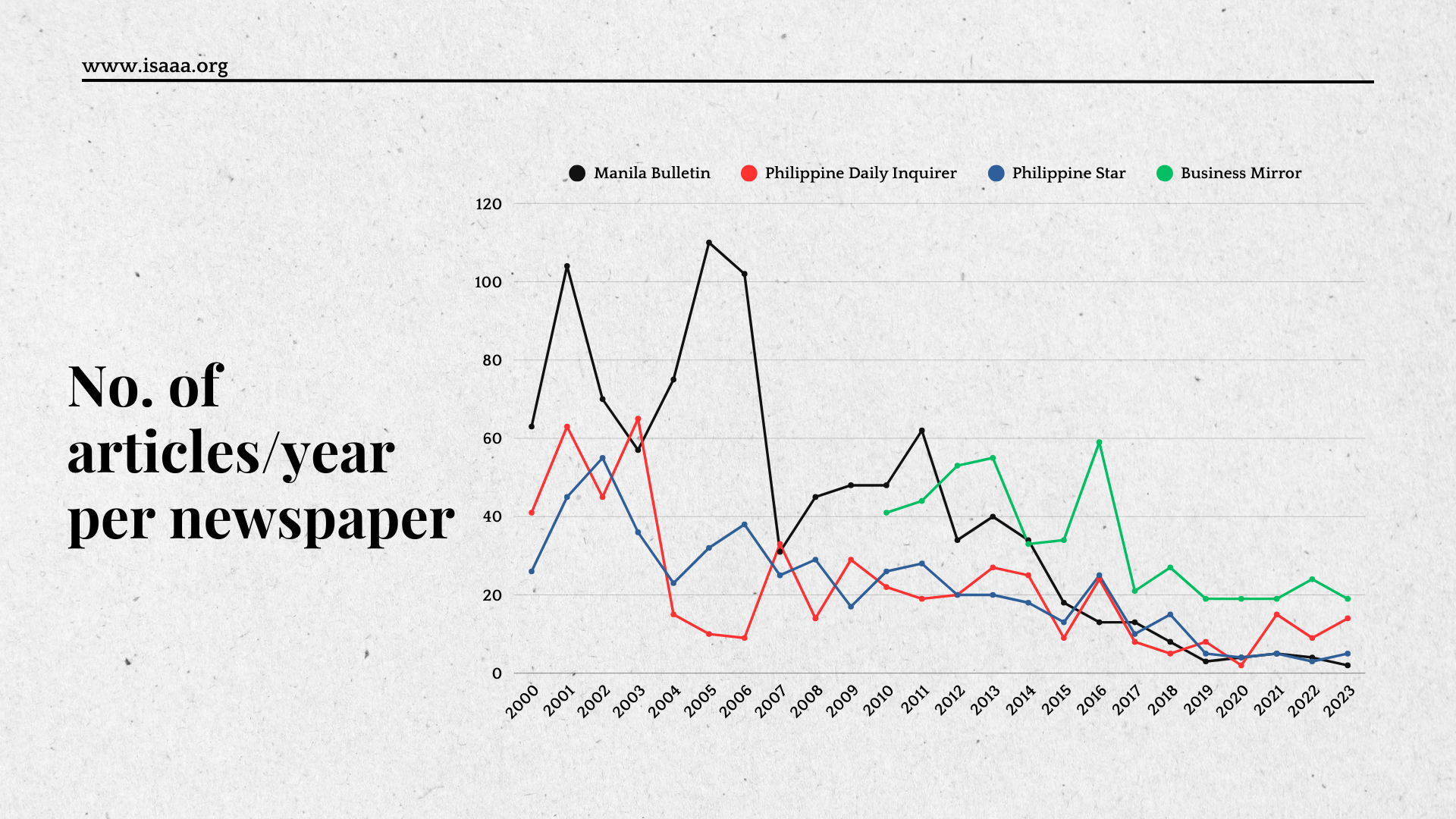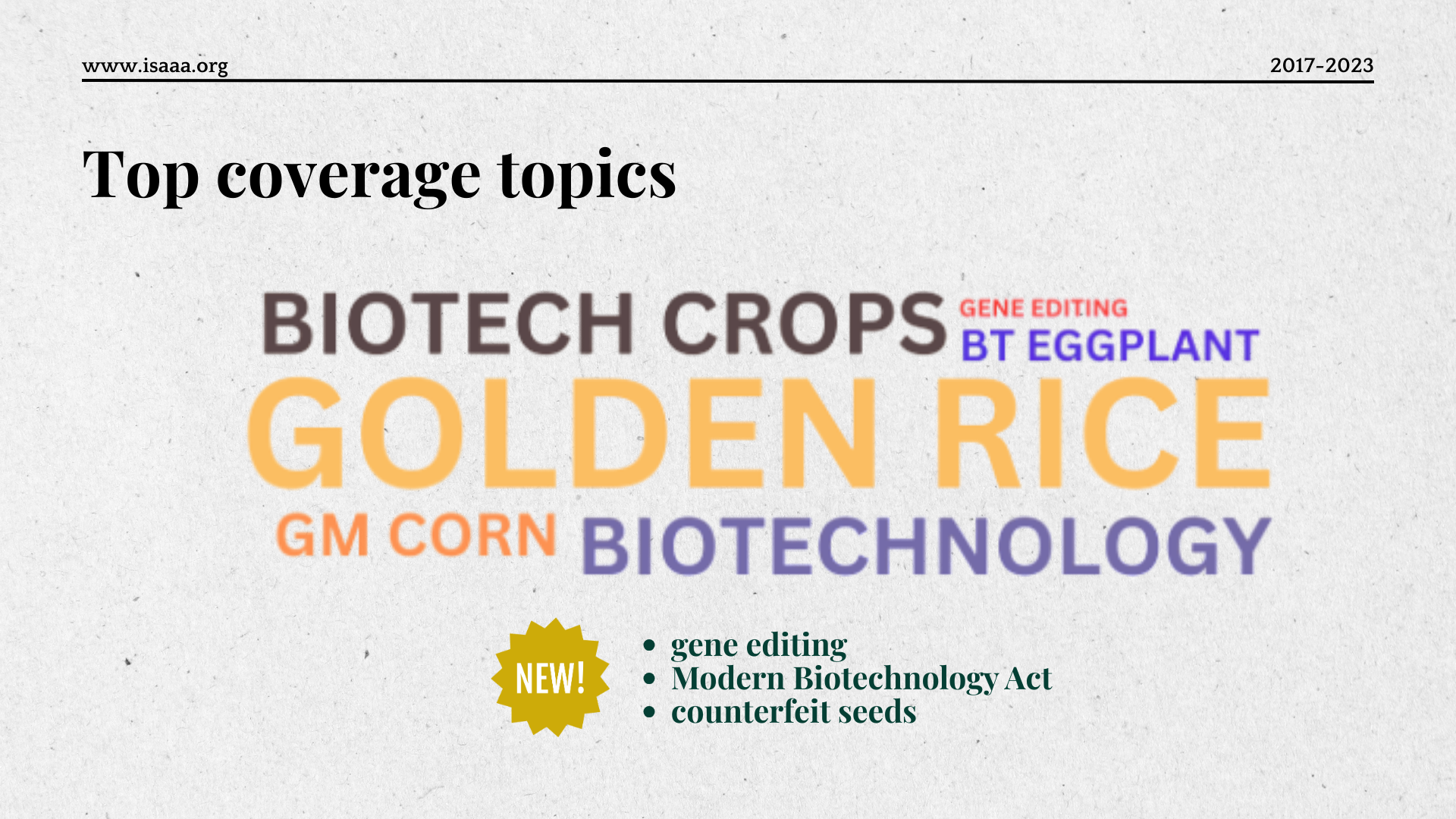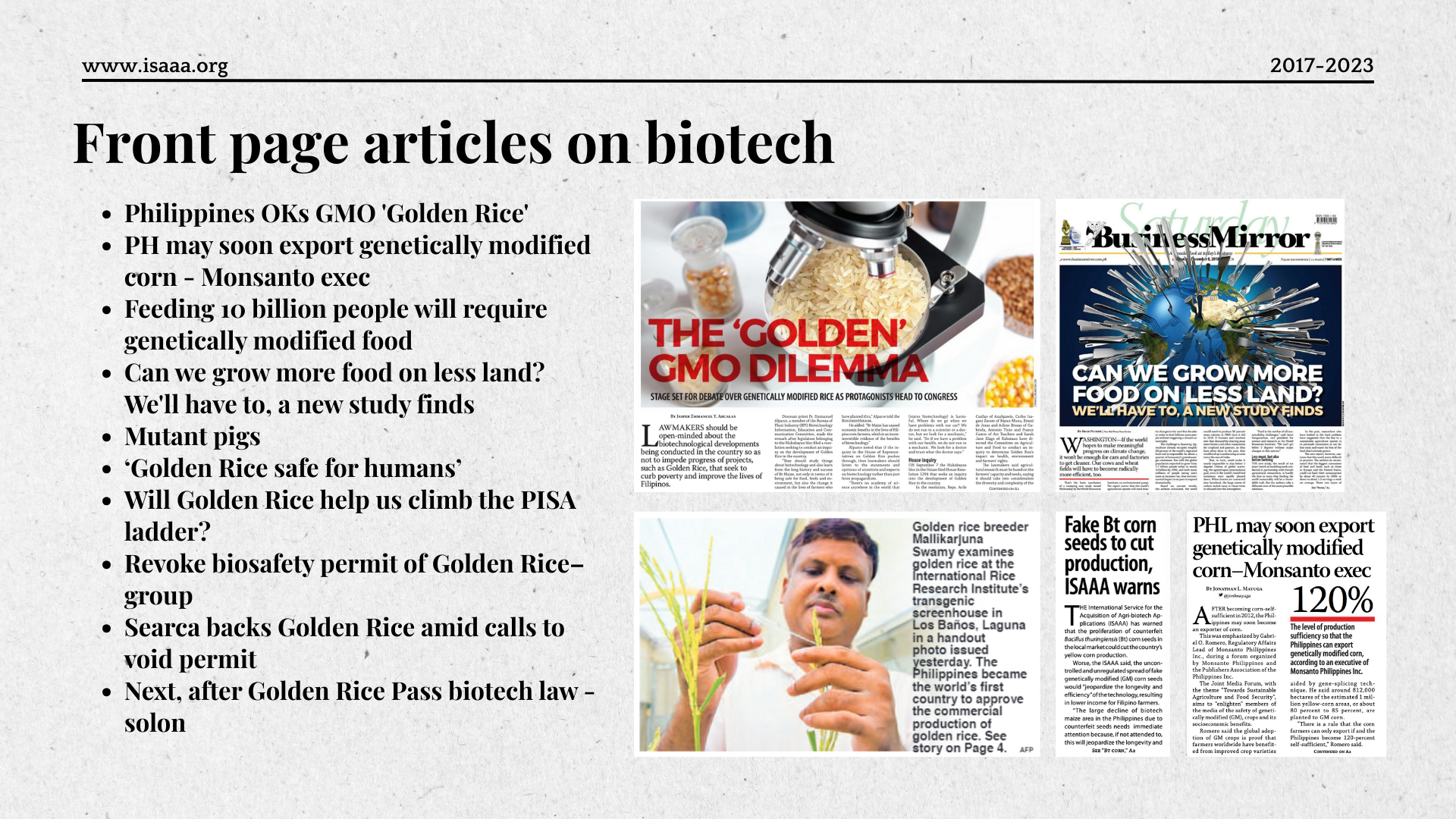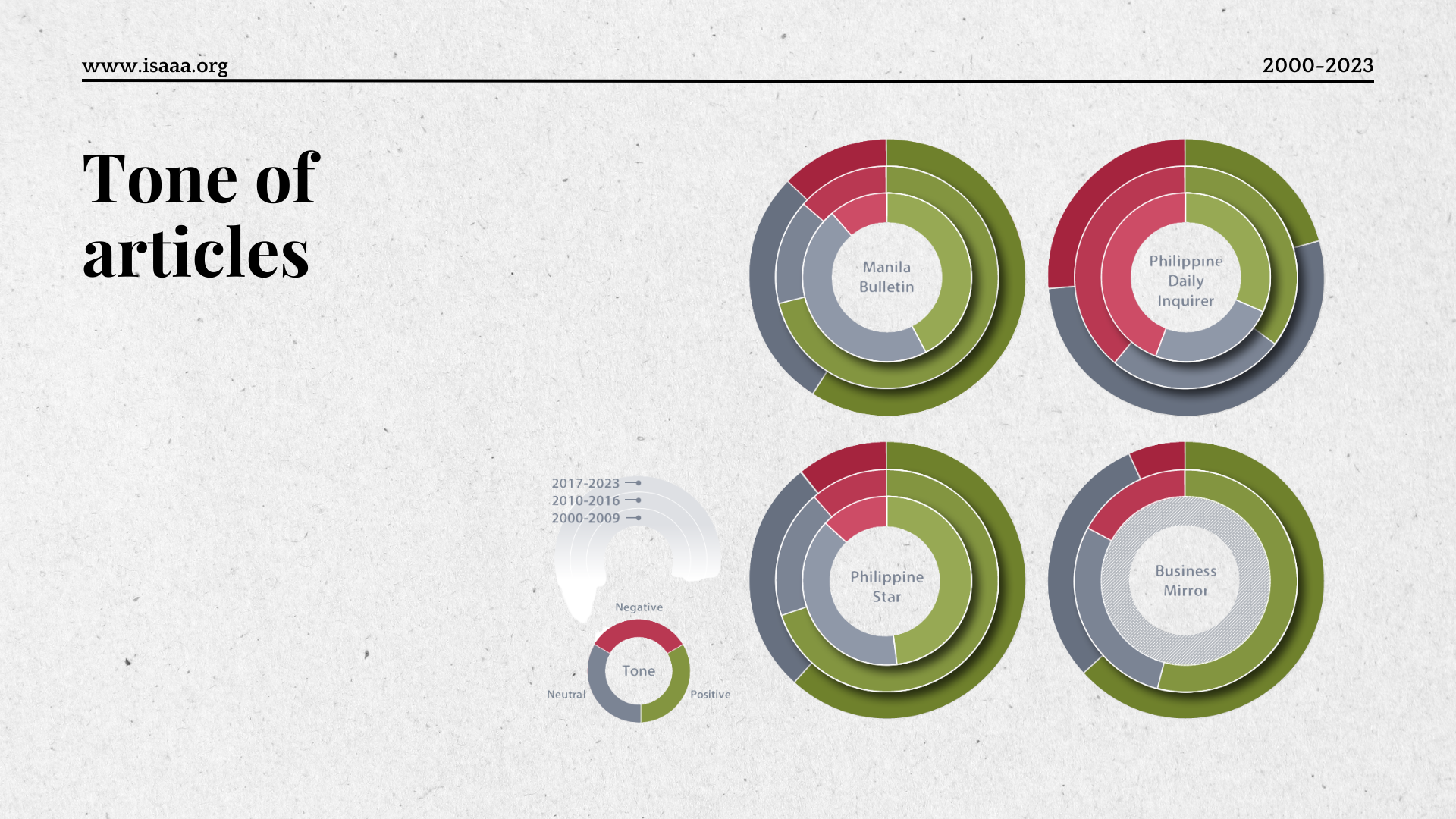How Does Philippine Media Report Agri-biotechnology?
| |
News media are one of the top sources of information on biotechnology in the Philippines. With a trust level of 3 out of 4, these sources could serve as our “thermometer” and “thermostat” for public acceptance.
The International Service for the Acquisition of Agri-biotech Applications (ISAAA), Inc. has been monitoring media reporting of agricultural biotechnology in the Philippines since 2000 to gauge how these critical sources of public information portray biotechnology. An initial study (Navarro et al., 2011) conducted a content analysis of print articles from 2000 to 2009 (10 years) from the top three national dailies in terms of circulation, namely Manila Bulletin, Philippine Daily Inquirer, and Philippine Star. A follow-up study (Tome et al., 2017) covered seven years of print and online articles (2010 to 2016) from the top three dailies mentioned, and BusinessMirror, which was observed to have a significant coverage on the topic during those years. A recent research analyzed another seven years (2017 to 2023) of articles from the same sources as the second study. The latest research completes the trilogy of content analyses, covering a total of 2,525 articles and spanning 24 years of biotech stories. This article summarizes the key findings of the third study and provides answers to relevant questions about the Philippine media's portrayal of biotechnology in the most-read national dailies.

What were the major events in biotechnology as covered in the stories?
From 2000 to 2023, a total of 2,525 articles on the applications of modern biotechnology in food and agriculture were published.
For the first 10 years (2000-2009), the significant occurrences reported were about the research and development of Bt corn leading to its commercialization in 2002 and the planting years, which started in 2003. These events and other topics generated over 1,355 print articles. In the following seven years (2010 to 2016), the stories shifted to the research and development of Bt eggplant and Golden Rice, which both gained significant public interest. A court case filed by environmental groups in 2012 against Bt eggplant further added to the biotech news coverage. These stories, along with other topics, generated 884 print and online articles.
From 2017 to 2023, the major events were the government approvals for Golden Rice and Bt eggplant, and another court case filed by environmental groups in 2023. These events and other stories were covered in 286 print and online articles. This collection shows a significant decline in the number of articles compared to the first two analyses. The same trend has been observed in the US, where science coverage in the traditional news media, such as newspapers, is decreasing.
Which newspaper published the most articles?
From 2017-2023, the widest coverage was delivered by BusinessMirror, with 147 articles in seven years (51.4%). The other three newspapers all garnered an article share ranging from 13 to 18%. BusinessMirror was also recorded to have the widest biotech coverage from 2010 to 2016. Manila Bulletin dominated the biotech coverage in the first analysis (2000-2009), which did not include BusinessMirror.

How did the topics shift through time?
The most recent analysis (2017-2023) showed that Golden Rice dominated the stories, which was found to be the main subject of 23% of the articles analyzed. Other main topics recorded were biotechnology, biotech crops, GM corn, Bt eggplant, and gene editing. New topics emerged in the latest analysis, including the emerging innovation CRISPR gene editing, the Modern Biotechnology Act filed by Rep. Sharon Garin in 2018, and the issue of counterfeit biotech maize seeds.

Did biotech reach the headlines?
A total of 10 articles made it to the front pages of printed newspapers from 2017 to 2023. The article titled “Philippines OKs GMO ‘Golden Rice’” appeared on the front page of the Philippine Star, while nine other articles appeared in the BusinessMirror headlines. Over half of these stories were about Golden Rice.

Who were the prominent writers?
A core group of writers consistently followed the biotechnology story, publishing at least one article per year from 2017-2023. The top five were Jasper Emmanuel Arcalas (previously with BusinessMirror, now with Philippine Star), Louise Maureen Simeon (Philippine Star), Dr. Emil Javier (Manila Bulletin Columnist), Lyn Resurreccion (BusinessMirror Science Editor), and Madelaine Miraflor (previously with Manila Bulletin). These writers are multi-awarded journalists, and one is hailed as a National Scientist. All of them demonstrated evidence-based reporting on biotechnology, with their articles maintaining a positive or neutral tone.

What were the top sources of information?
From 2000 to 2023, one group consistently came out to be the most quoted source of information: government agencies and officials. They were the main source for writers in all phases of the analysis. In the earlier years (2000-2009), civil society groups and international organizations were also major sources. Then, from 2010 to 2016, international organizations took a more prominent role. From 2017 to 2023, government agencies were cited in nearly 30% of articles, mentioning key government agencies regulating biotechnology, such as the Department of Agriculture and the Department of Science and Technology. International organizations such as ISAAA and the International Rice Research Institute (IRRI) also appeared frequently in the articles. A decline of civil society groups as a source was noted from 2017 to 2023. This might mean that writers are relying more on official sources and scientists for their information, and less on statements from civil society and environmental groups. It may also suggest that government sources are readily available or more accessible than information from other sources.
What message frames and metaphors were used for biotech?
Framing is a key concept commonly used in media and communication to package a message or a concept. To further characterize how the media portrayed the concept of biotechnology, the articles were sorted by message frames and checked for the use of metaphors. From 2017 to 2023, over 40% of the articles were framed around public accountability or governance. This finding coincides with the result that government officials were the most-cited sources in the articles. The second most popular frame was social progress, at 28%. The initial analysis (2000-2009) also had a similar trend, while the second analysis (2010-2016) showed social progress as the key frame used by the writers.
As for the use of metaphors, a declining trend was evident. The initial years of reporting (2000-2009) recorded 137 articles with fear-based metaphors such as "frankenfood," "monster," and "bomb." From 2010 to 2016, fear metaphors were still used, but to a lesser extent. At the same time, we saw a rise in positive metaphors, describing biotechnology as a "new hope" or the "answer to farmers' dreams." From 2017 to 2023, metaphors were rarely found in the articles and were much milder. Only 10 articles—just 3.5% of the total—used fear-based metaphors, with phrases like “false miracle solution” or “band-aid solution to hunger.”
What was the main sentiment/tone?
As for the overall tone of the media coverage, the latest analysis revealed that all newspapers, except for the Philippine Daily Inquirer, had a generally positive or neutral view of biotechnology, as the data showed over half of the articles were positive, and a third were neutral. Articles citing biotech critics showed negative sentiment (12%), mostly related to health scares.

Looking ahead, diving deeper
The 24-year analysis shows a shifting editorial perspective, moving towards more evidence-based and less sensationalized reporting. Streaks in the release of stories were evident with the occurrence of key biotech events, such as government approvals and court cases filed by environmental groups. With government agencies and authorities as primary sources of information on the topic, the writers frequently framed their stories toward public accountability or governance. Thus, political will toward the adoption of biotech products may lead to a favorable acceptance of biotechnology, unblocking the potential of these products to deliver benefits such as contributing to food security and sustainability.
For a more holistic understanding of biotech media reporting, the researchers recommend that future media reportage include stories released through other communication channels, such as broadcast and social media. Regular engagement among media practitioners, developers, regulators, and end-users (farmers and consumers) is crucial for journalists to relay biotech information with a deeper understanding and wider perspective. This will lead to fact-based biotech coverage that equips the public to make informed decisions regarding the adoption and use of biotech products.
| Newer Post | Archive | Older Post |
Science Speaks is ISAAA Inc.'s official blog. Weekly blog articles, authored by ISAAA writers, partners, and invited contributors, aim to help share, disseminate, and promote scientific knowledge and its vital role in achieving global agricultural sustainability and development. Your support to Science Speaks will help us achieve this goal. You can help us by donating as little as $10.

